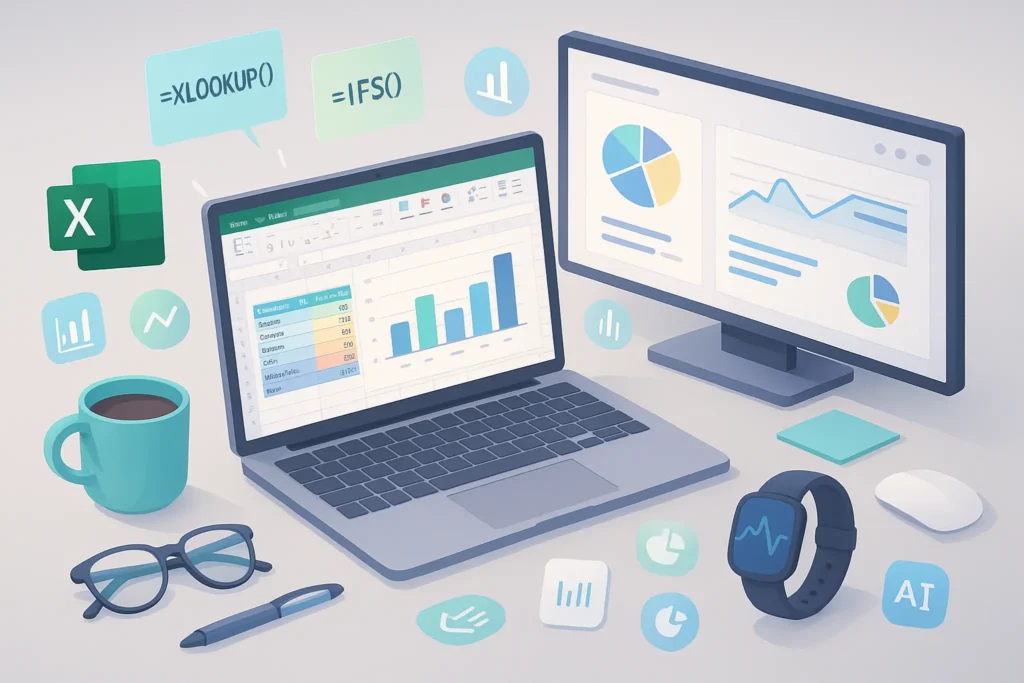-This post may contain affiliate links. If you click on one and make a purchase, I may earn a small commission at no extra cost to you.-
🔍 Introduction: Why Excel Is Still King for Data Pros
Despite the rise of Python notebooks, Power BI dashboards, and AI-driven analytics, Microsoft Excel remains an irreplaceable powerhouse in the world of data. From finance to operations to marketing, millions still rely on Excel for quick modeling, exploration, and reporting.
But most users only scratch the surface.
In this post, we’ll break down 10 advanced Excel techniques that will make you faster, sharper, and way more confident with large datasets. These aren’t beginner basics—you’ll learn the actual tools that data pros and analysts use daily to find insights and automate the boring stuff.
Let’s dive in.
✅ Tip 1: Use Dynamic Named Ranges with Excel Tables
Excel tables (Ctrl + T) aren’t just for aesthetics—they convert your dataset into a dynamic range that auto-expands as you add data. You can reference columns by name (Sales[Amount]) and create formulas that don’t break when you add rows.
🧠 Real Use Case:
A financial analyst managing monthly reports builds a formula referencing =SUM(Sales[Amount]). As new rows are added each week, the formula updates automatically—no more dragging ranges or fixing broken cells.
💡 Nerd-Tip: You can name your tables (e.g., tbl_Sales) to make formulas ultra-clear.
✅ Tip 2: Master Pivot Tables for Instant Summarization
Pivot tables let you turn raw data into aggregated reports with just a few clicks. You can group data, calculate averages, apply filters, and even build charts—all without writing a single formula.
🧠 Real Use Case:
A project manager needs to analyze task durations across teams. With a pivot table, she summarizes average completion time by department and project phase in under 2 minutes—then exports it for Monday’s meeting.
💡 Nerd-Tip: Use the “% of Column Total” function to see contribution ratios instantly.
Pair this with our 20 Windows 11 Keyboard Shortcuts That Will Seriously Boost Your Productivity to navigate Excel like a ninja.
✅ Tip 3: Use XLOOKUP Instead of VLOOKUP
XLOOKUP is the modern, smarter version of VLOOKUP—it searches both left and right, returns exact matches by default, and doesn’t break when column order changes.
🧠 Real Use Case:
A sales analyst matches invoice IDs to price values using XLOOKUP instead of nesting IFERROR(VLOOKUP(...)). It’s cleaner, faster, and future-proof.
💡 Nerd-Tip: Combine XLOOKUP with IFNA() for custom error messages.
✅ Tip 4: Clean Messy Data with Power Query
Power Query lets you clean, transform, and reshape data before it even enters your sheet. No more using 7 helper columns to fix spacing issues or date formats—it’s all done in the Query Editor.
🧠 Real Use Case:
A marketer imports CSV files weekly from an ad platform. Power Query automatically trims text, converts columns, filters dates, and loads a clean table ready for analysis—all in one click.
💡 Nerd-Tip: Use “Unpivot Columns” to reshape cross-tab data into analysis-ready rows.
✅ Tip 5: Build Dynamic Dashboards with Slicers + Charts
Slicers allow users to filter Pivot Tables and Charts visually. When combined with structured tables and pivot data, you can build interactive dashboards that non-technical teams can use without touching formulas.
🧠 Real Use Case:
A business consultant creates a dynamic KPI dashboard for a client. Using slicers, the client can filter metrics by region, product line, or quarter—all without breaking the spreadsheet.
💡 Nerd-Tip: Use Timeline Slicers for date-based navigation in dashboards.
✅ Tip 6: Automate Repetitive Tasks with Macros (and Recorders)
If you find yourself repeating the same steps (e.g., formatting reports, inserting rows, cleaning columns), Excel macros can automate those workflows. Even without writing VBA, the Macro Recorder can capture your actions and replay them with one click.
🧠 Real Use Case:
A data entry assistant builds a macro that formats sales reports with company colors, inserts totals, and exports to PDF. What used to take 25 minutes now takes 5 seconds.
💡 Nerd-Tip: Store your macros in the “Personal Macro Workbook” so they’re available in all Excel files.
✅ Tip 7: Use Named Ranges in Complex Formulas
When your formulas get complicated—especially in financial modeling or multi-sheet workbooks—named ranges help make everything easier to read and debug.
🧠 Real Use Case:
An operations manager creates a KPI dashboard where all core metrics like Target_Conversion or Budget_Growth are defined as named ranges. When formulas break, debugging becomes intuitive—not frustrating.
💡 Nerd-Tip: Use F3 to paste or manage all your named ranges quickly.
✅ Tip 8: Master Conditional Formatting for Insight at a Glance
Turn numbers into immediate visual cues using conditional formatting—color scales, icons, data bars. It’s not just pretty—it makes analysis faster and more intuitive.
🧠 Real Use Case:
An HR analyst uses conditional formatting to highlight departments with over 10% attrition or underperformance based on survey scores. Management can now spot problem areas at a glance.
💡 Nerd-Tip: Use formulas inside conditional formatting for deeper logic (e.g., highlight overdue invoices =TODAY()>Due_Date).
✅ Tip 9: Nest IF + IFS + AND/OR for Smart Logic
Don’t overcomplicate logic with a mess of IF(IF(IF(...))). Use the newer IFS function or logical operators like AND() / OR() to make formulas more elegant and easier to read.
🧠 Real Use Case:
A product manager categorizes products based on performance, margin, and region—all in a single nested formula without making it a spaghetti mess.
💡 Nerd-Tip: Combine with LET() to define internal variables for cleaner, faster formulas.
✅ Tip 10: Protect Your Workbooks Like a Pro
You’ve built a gorgeous report, added advanced formulas, and a dashboard. Don’t let someone accidentally break it. Use sheet protection, data validation, and hidden formulas to secure your work.
🧠 Real Use Case:
A financial planner distributes budget templates to clients, but locks all formula cells and hides columns with sensitive logic, ensuring no one breaks the spreadsheet accidentally.
💡 Nerd-Tip: Use “Allow Users to Edit Ranges” for granular permission settings.
Want to bring this level of structure to the rest of your tools? Read How to Organize Your Digital Life.
🔄 Bonus Section: Real-World Excel Use Case Templates (By Role)
👨💼 For Business Analysts:
-
Dynamic KPI dashboard using Pivot Tables + Slicers
-
Formula toolkit:
SUMIFS,XLOOKUP,INDEX/MATCH,LET
📈 For Financial Professionals:
-
Budget model with drop-down scenario planning
-
Use of Data Validation + Named Ranges + Conditional Formatting
🧑🎨 For Content Creators:
-
Content calendar with auto color-coded deadlines
-
Use of
TODAY(),NETWORKDAYS(), and custom columns
💻 New Feature Spotlight: Excel Copilot (AI Assistant)
In Excel 2025, Copilot (powered by Microsoft AI) lets you ask natural language questions about your data, and it builds formulas or even charts for you.
Example Prompts:
-
“Show me which product category grew the fastest last quarter”
-
“Make a chart comparing Q1 and Q2 sales by region”
💡 Nerd Tip: You can still edit or reverse-engineer what Copilot creates to learn the formulas behind it.
🔐 Bonus Tip: Version Control + Audit Trails
When working with large teams, Excel’s version control options can save you from disaster. Use these built-in tools:
-
Track Changes (under Review tab)
-
Sheet Protection (with specific editable ranges)
-
Cell comments + Notes for explaining formulas
🛠️ Add-On Tools Worth Exploring
-
Power BI Integration: Push Excel tables directly into Power BI
-
Kutools for Excel: Adds 300+ extra functions & shortcuts
-
ASAP Utilities: Amazing batch processing for data-heavy users
📝 Quick Reference: Excel Formula Library for Data Analysis
| Formula | Purpose / Use Case |
|---|---|
XLOOKUP() |
Replaces VLOOKUP/HLOOKUP; allows left-right lookup with custom error handling. |
LET() |
Assigns names to intermediate values inside complex formulas—cleaner & faster. |
FILTER() |
Extracts dynamic, filtered subsets of data based on conditions. |
UNIQUE() |
Returns distinct values from a column or range—perfect for category extraction. |
TEXTJOIN() |
Joins text from multiple cells with a custom delimiter (e.g., comma, space). |
IFS() |
Replaces complex nested IF() formulas for cleaner logic flows. |
SUMIFS() |
Conditional summing based on multiple criteria (e.g., sum of sales in a region & month). |
COUNTIFS() |
Counts entries meeting multiple conditions—great for dashboards or QA checks. |
INDEX() + MATCH() |
More flexible alternative to VLOOKUP, especially when you need left-hand lookups. |
SEQUENCE() |
Generates an array of sequential numbers—useful in automation or time-based data. |
CHOOSE() |
Selects a value from a list based on position—great for dynamic scenario models. |
ROUND() / ROUNDUP() / ROUNDDOWN() |
Control precision for reporting or standardization. |
TODAY() / NOW() |
Inserts dynamic dates/time; used in due date logic and time-based formulas. |
💡 Tip: Many of these functions shine when combined with Excel’s new Dynamic Arrays (introduced in 365+), making your formulas spill into multiple cells automatically.
🧠 Nerd Verdict
Excel is still one of the most underrated superpowers in data analysis—when used right. Most people only use 10–20% of what Excel can actually do.
If you want to stand out as a data-savvy pro:
-
Learn pivot tables like second nature
-
Embrace Power Query for real-world data cleanup
-
Use
XLOOKUP, macros, and structured tables to save hours per week -
Build clean dashboards that explain themselves
-
And above all, stay curious—Excel evolves every year
🎯 Bottom line: Mastering Excel isn’t about memorizing tricks—it’s about building intuition and repeatable systems.
❓ FAQ: Nerds Ask, We Answer
Q: Is Excel still relevant in a world of AI and Power BI?
Absolutely. Excel is the most flexible, portable, and widely adopted data tool on the planet. AI-enhanced tools like Copilot only make it more powerful.
Q: Can I learn all this without coding?
Yes! Almost everything in this post can be done without touching VBA. Excel is becoming more “low-code” than ever.
Q: What’s the fastest way to get better?
Start using structured tables, pivot tables, Power Query, and XLOOKUP. Watch YouTube tutorials or recreate real dashboards from scratch.
Q: How can I integrate this into my productivity system?
Use Excel to track goals, habits, content calendars, or budgeting—see our guide on How to Set Up a Productivity System That Actually Works.
💬 Would You Bite?
Which Excel trick or workflow made the biggest difference in your career?
Share your favorite pro tip or a hard-won formula in the comments—we’ll feature the best ones in our next roundup! 👇



